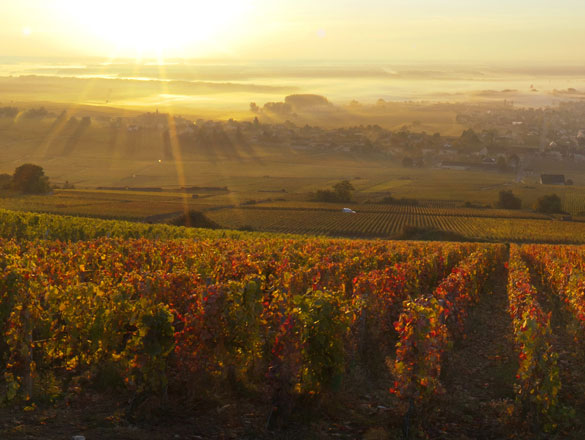

The vineyards of Bourgogne produce some great wines with a historical and international reputation. However, the region is not simply limited to its iconic appellations. In addition to its Village Premier Cru and Grand Cru AOCs, it also produces a range of wonderful Régionale and Village appellations to explore.
You will also find a full list of the Bourgogne’s Climats and lieux-dits on this page.
Check out the complete list of the 84 Bourgogne appellations.
However, your exploration has only just begun. Bourgogne wines have never before offered such high quality. Besides our range of internationally celebrated wines, try some of our lesser-known appellations where there are lots of surprises in store.
And for a fun way to find out more about the wines on offer, try out our “Which Bourgogne wine is right for me?” quiz, or check out Bourgogne Maps to take an interactive tour of the region.
Grand Cru appellation
VIGNOBLE DE LA CÔTE DE BEAUNE
31 juillet 1937
Mainly reds - Pinot Noir.
Whites - Chardonnay.
Area under production*:
1 hectare (ha) = 10,000 m² = 24 ouvrées.
Reds: 87.04 ha
Whites: 3.95 ha
Average annual yield**:
1 hectolitre (hl) = 100 litres = 133 bottles.
Reds: 2,671 hl (355,243 bottles)
Whites: 138 hl (18,354 bottles)
*In 2022 **5-year average, 2017-2021
Appellation Grand Cru of the Côte de Beaune region (Côte-d’Or).
This appellation may be followed by the name of the Climat of origin (applies to red wines only).
Producing communes: Aloxe-Corton, Ladoix-Serrigny, Pernand- Vergelesses.
On the label, the words GRAND CRU must appear immediately below the name of the appellation in characters of identical size.

The extensive area covered by this appellation Grand Cru and the large number of different Climats it contains explain the observable differences in character among the wines grown here. The rare whites (grown mainly in the Climats of Vergennes and Languettes) have a keeping potential of 4-10 years. Colour: pale gold with green highlights. Mineral aromas (flint) blend with butter, baked apple, bracken, cinnamon and honey. Elegant and highly-bred, supple and well rounded, this unusual Chardonnay has much in common with Corton-Charlemagne. The Corton reds are an intense velvety crimson, darkening towards magenta. Their generous aromatic expression is of fruit notes (blueberry, gooseberry, kirsch cherry) or flowers (violet), evolving towards underbrush, animal, leather, fur, pepper and liquorice. On the palate this wine is well-built, powerful and muscular and the chewy body comes to the fore. Firm, frank and fat, it requires time (4-12 years) to reach its peak.

Red: solid and opulent, Corton is a Bourgogne’s iconic - highly complex, impressively mouth-filling in a way that is at once sensual and structured.
For this reason, strong soft-centred cheeses and blue cheeses are needed to tame it. But, without question, its closest companions are highlyflavoured meats that match its powerful flavours and intense aromas.
Indeed this wine is sublime with roast or grilled beef, or any and all game (furred or feathered) roasted, braised or - naturally - in sauce.
Serving temperature: 14 to 16°C.
White: white Corton is a natural match for shellfish, fish, poultry in cream sauce, and goat’s cheese.
Serving temperature: 12 to 14°C.

The Hill of Corton lies in the midst of a cluster of famous wine-growing villages - Ladoix-Serrigny, Aloxe-Corton, Pernand-Vergelesses and Savigny-lès-Beaune - with, to the North, the southern end of the Côte de Nuits where vineyards mingle with stone quarries (Comblanchien limestone). The vineyards lie at heights of 250-330 metres and form a kind of amphitheatre not found elsewhere in the Côte. The Hill of Corton produces white Corton-Charlemagne and (mainly) red Corton, described by Camille Rodier as “le roi des bonsvivants” (or “the king of the bon vivants”). Corton Grand Cru received its AOC status on 31 July, 1937. A small quantity of white wine is grown but only the reds have the right to add the name of their Climat to that of the appellation.

Exposure is South-East/South-West (not an arrangement frequently found in the Côte). The hillside offers a text-book cut-away illustration of the local geology. The Oxfordian Jurassic limestone lying between Ladoix and Meursault is younger (145 million years) here than elsewhere along the Côte. At mid-slope the gradient is gentle and the soil reddish and pebbly, derived from brown limestone and rich deposits of marl with high potassium content. The Pinot Noir grape is pampered here. The Chardonnay grape (which gives us the Corton Charlemagne) occupies the top of the slope (See Appellation sheets No. 31).
